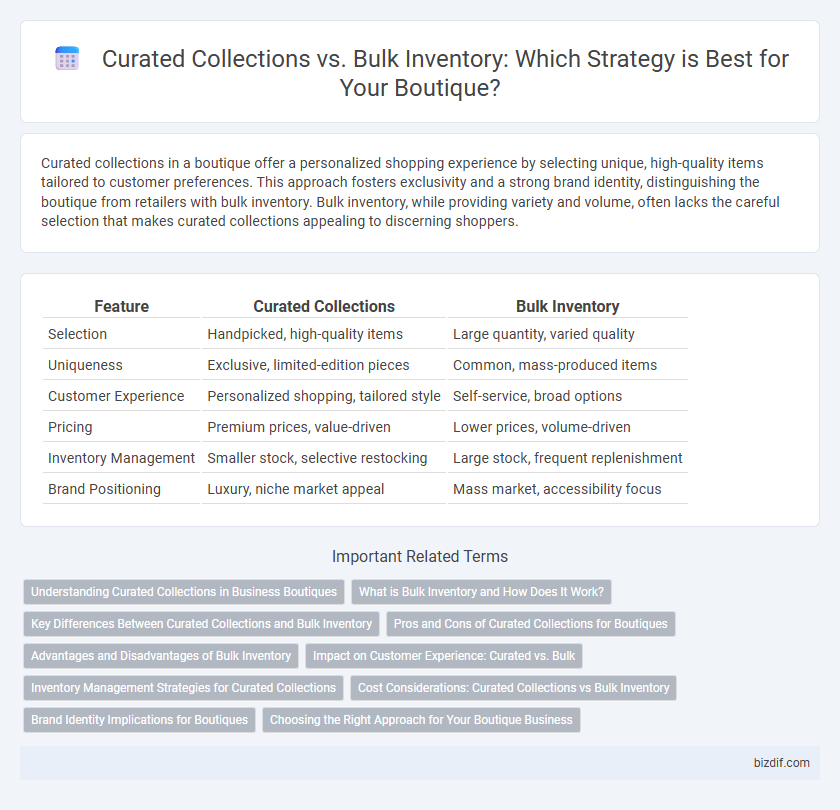Curated collections in a boutique offer a personalized shopping experience by selecting unique, high-quality items tailored to customer preferences. This approach fosters exclusivity and a strong brand identity, distinguishing the boutique from retailers with bulk inventory. Bulk inventory, while providing variety and volume, often lacks the careful selection that makes curated collections appealing to discerning shoppers.
Table of Comparison
| Feature | Curated Collections | Bulk Inventory |
|---|---|---|
| Selection | Handpicked, high-quality items | Large quantity, varied quality |
| Uniqueness | Exclusive, limited-edition pieces | Common, mass-produced items |
| Customer Experience | Personalized shopping, tailored style | Self-service, broad options |
| Pricing | Premium prices, value-driven | Lower prices, volume-driven |
| Inventory Management | Smaller stock, selective restocking | Large stock, frequent replenishment |
| Brand Positioning | Luxury, niche market appeal | Mass market, accessibility focus |
Understanding Curated Collections in Business Boutiques
Curated collections in business boutiques emphasize carefully selected products that reflect the brand's unique identity and meet specific customer preferences, enhancing exclusivity and perceived value. This approach contrasts with bulk inventory, which prioritizes volume and variety but may dilute brand distinction and customer experience. By focusing on curated collections, boutiques foster stronger customer loyalty and differentiate themselves in competitive markets.
What is Bulk Inventory and How Does It Work?
Bulk inventory refers to large quantities of merchandise stocked by retailers, enabling quicker fulfillment and often lower per-unit costs. It involves purchasing substantial volumes of products directly from manufacturers or wholesalers to maintain consistent availability and meet high customer demand. This approach contrasts with curated collections by emphasizing quantity and variety to optimize inventory turnover and reduce stockouts.
Key Differences Between Curated Collections and Bulk Inventory
Curated collections emphasize quality, uniqueness, and thematic coherence, often featuring limited-edition or handpicked items tailored to a specific customer niche. Bulk inventory prioritizes quantity, broad variety, and cost-efficiency, enabling higher stock volumes and faster turnover but often sacrificing exclusivity. The key differences lie in customer experience, inventory management, and brand positioning, where curated collections enhance brand identity and customer loyalty while bulk inventory supports scalability and competitive pricing.
Pros and Cons of Curated Collections for Boutiques
Curated collections in boutiques offer a distinctive and personalized shopping experience by carefully selecting products that align with the brand's aesthetic and target audience, enhancing customer loyalty and perceived value. However, the limited inventory can lead to challenges in meeting diverse customer demands and may result in slower turnover compared to bulk inventory models. This approach requires meticulous market research and trend analysis to maintain relevance while balancing exclusivity with product variety.
Advantages and Disadvantages of Bulk Inventory
Bulk inventory allows boutiques to maintain a wide range of products at competitive prices, facilitating consistent stock availability for high-demand items. However, it requires significant upfront investment and increases storage costs, which can lead to cash flow challenges and potential overstock issues. Unlike curated collections, bulk inventory may lack unique appeal, risking reduced customer engagement and limited brand differentiation.
Impact on Customer Experience: Curated vs. Bulk
Curated collections enhance customer experience by offering personalized, thoughtfully selected items that align with specific tastes and trends, fostering a sense of exclusivity and trust. Bulk inventory often leads to overwhelming choices, reducing the ease of decision-making and potentially diminishing customer satisfaction. Boutiques prioritizing curated collections benefit from higher engagement and repeat visits due to the tailored shopping experience.
Inventory Management Strategies for Curated Collections
Inventory management strategies for curated collections emphasize selective stock replenishment based on customer preferences and sales analytics to maintain exclusivity and minimize overstock. This approach leverages demand forecasting and just-in-time ordering to optimize turnover rates and enhance liquidity. Boutique retailers benefit from integrating advanced inventory software to track limited-edition items, ensuring a balanced assortment that aligns with brand identity and market trends.
Cost Considerations: Curated Collections vs Bulk Inventory
Curated collections typically incur higher per-unit costs due to the emphasis on quality, uniqueness, and limited quantities, which justify premium pricing in boutique settings. Bulk inventory benefits from economies of scale, reducing acquisition costs and enabling competitive pricing but may increase risks of unsold stock and less exclusive offerings. Cost considerations favor curated collections when targeting niche markets valuing exclusivity, while bulk inventory suits larger volume sales with lower margins.
Brand Identity Implications for Boutiques
Curated collections enhance a boutique's brand identity by showcasing unique, carefully selected items that align with the store's aesthetic and values, fostering customer loyalty and exclusivity. In contrast, bulk inventory risks diluting the boutique's distinctiveness, as mass-produced or widely available products may undermine its carefully crafted image. Prioritizing curated selections allows boutiques to reinforce their market positioning and attract discerning clientele seeking personalized shopping experiences.
Choosing the Right Approach for Your Boutique Business
Curated collections offer boutiques a distinctive inventory tailored to their target market, enhancing customer experience and brand identity through unique, handpicked items. Bulk inventory focuses on stock volume, allowing for competitive pricing and consistent availability but may risk diluting boutique exclusivity. Selecting the right approach depends on your boutique's brand positioning, customer preferences, and long-term growth strategy to balance originality with operational efficiency.
Curated Collections vs Bulk Inventory Infographic

 bizdif.com
bizdif.com